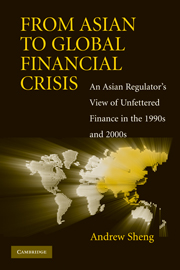 From Asian to Global Financial Crisis
From Asian to Global Financial Crisis Book contents
- Frontmatter
- Contents
- List of Figures
- List of Tables
- Acknowledgements
- Introduction
- 1 Things Fall Apart
- 2 Japan and the Asian Crisis
- 3 The Beam in Our Eyes
- 4 Banking: The Weakest Link
- 5 Washington Consensus and the IMF
- 6 Thailand: The Karma of Globalization
- 7 South Korea: Strong Body, Weak Heart
- 8 Malaysia: The Country That Went Its Own Way
- 9 Indonesia: From Economic to Political Crisis
- 10 Hong Kong: Unusual Times Need Unusual Action
- 11 China: Rise of the Dragon
- 12 From Crisis to Integration
- 13 The New World of Financial Engineering
- 14 What's Wrong with Financial Regulation?
- 15 The Global Financial Meltdown
- 16 A Crisis of Governance
- From Asian to Global Crisis: Chronology of Notable Events
- Abbreviations and Acronyms
- Bibliography
- Index
10 - Hong Kong: Unusual Times Need Unusual Action
Published online by Cambridge University Press: 05 June 2012
- Frontmatter
- Contents
- List of Figures
- List of Tables
- Acknowledgements
- Introduction
- 1 Things Fall Apart
- 2 Japan and the Asian Crisis
- 3 The Beam in Our Eyes
- 4 Banking: The Weakest Link
- 5 Washington Consensus and the IMF
- 6 Thailand: The Karma of Globalization
- 7 South Korea: Strong Body, Weak Heart
- 8 Malaysia: The Country That Went Its Own Way
- 9 Indonesia: From Economic to Political Crisis
- 10 Hong Kong: Unusual Times Need Unusual Action
- 11 China: Rise of the Dragon
- 12 From Crisis to Integration
- 13 The New World of Financial Engineering
- 14 What's Wrong with Financial Regulation?
- 15 The Global Financial Meltdown
- 16 A Crisis of Governance
- From Asian to Global Crisis: Chronology of Notable Events
- Abbreviations and Acronyms
- Bibliography
- Index
Summary
If small fortune does not go out, large fortune will not come in.
~ Hong Kong tycoonIn late 1996 one of the managing directors of Soros Management, Arminio Fraga, read an article by Professor Carmen Reinhart from the University of Maryland on the vulnerabilities of the East Asian economies. He passed the article to George Soros. In his book The Crisis of Global Capitalism, Soros admitted that his fund management company anticipated the Asian crisis at least six months before it happened. The fund sold short the Thai baht and Malaysian ringgit early in 1997 with maturities ranging from six months to a year.
PLACING YOUR BETS IN CURRENCY BATTLES: CENTRAL BANKS OR THE HEDGE FUNDS?
Hedge funds were invented in 1949, reputedly by Alfred Winslow Jones, who first leveraged his investments, sold short positions, had a limited partnership to avoid having greater regulation and took 20 percent of profits as performance fees. Initially they were slow to grow, but George Soros made hedge funds famous when his funds took a US$10 billion short position against the Bank of England. On the famous Black Wednesday, 16 September 1992, the Bank of England had to abandon the exchange rate mechanism (ERM) after it spent US$15 billion to support the pound and raised interest rates to as high as 15 percent to prevent sterling devaluation. Soros was reputed to have made about US$1.1 billion from this trade.
- Type
- Chapter
- Information
- From Asian to Global Financial CrisisAn Asian Regulator's View of Unfettered Finance in the 1990s and 2000s, pp. 253 - 277Publisher: Cambridge University PressPrint publication year: 2009


